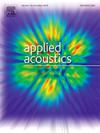Design of subwavelength wide bandwidth sound absorbers by inverse convolutional neural networks
IF 3.4
2区 物理与天体物理
Q1 ACOUSTICS
引用次数: 0
Abstract
Microperforated panel sound absorber metamaterials are crucial for noise reduction in various applications. This study leverages a convolutional neural network (CNN) machine learning model to optimise these metamaterials for maximum absorption strength and bandwidth range. The model allows for inverse optimisation of sound absorption performance. A desired absorption response can be supplied as input, and the network returns the necessary geometry parameters to achieve the target characteristic.
Metamaterials were optimised to provide over 90 % absorption at target frequencies between 0–1000 Hz. Theoretical predictions were validated experimentally via impedance tube testing. The model achieved no less than 70 % absorption over a 923 Hz range (548–1471 Hz) with a material thickness of 41 mm, and 70 % absorption over 1000 Hz (470–1470 Hz) with a thickness of 57 mm. A case study for an automotive/energy application targeted 50 % absorption between 500–1000 Hz at a thickness of less than 25 mm. Experimental results showed 50 % absorption between 506–1032 Hz at 23 mm thickness. These findings demonstrate the potential of CNN models in optimising sound absorber metamaterials, offering significant improvements in noise reduction with minimal material thickness. The proposed methodology offers significant potential for lightweight applications in various noise-reduction scenarios, including automotive, aerospace, energy, and architectural acoustics.
求助全文
约1分钟内获得全文
求助全文
来源期刊

Applied Acoustics
物理-声学
CiteScore
7.40
自引率
11.80%
发文量
618
审稿时长
7.5 months
期刊介绍:
Since its launch in 1968, Applied Acoustics has been publishing high quality research papers providing state-of-the-art coverage of research findings for engineers and scientists involved in applications of acoustics in the widest sense.
Applied Acoustics looks not only at recent developments in the understanding of acoustics but also at ways of exploiting that understanding. The Journal aims to encourage the exchange of practical experience through publication and in so doing creates a fund of technological information that can be used for solving related problems. The presentation of information in graphical or tabular form is especially encouraged. If a report of a mathematical development is a necessary part of a paper it is important to ensure that it is there only as an integral part of a practical solution to a problem and is supported by data. Applied Acoustics encourages the exchange of practical experience in the following ways: • Complete Papers • Short Technical Notes • Review Articles; and thereby provides a wealth of technological information that can be used to solve related problems.
Manuscripts that address all fields of applications of acoustics ranging from medicine and NDT to the environment and buildings are welcome.
 求助内容:
求助内容: 应助结果提醒方式:
应助结果提醒方式:


